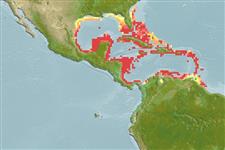Common names from other countries
Environment: milieu / climate zone / depth range / distribution range
Écologie
Récifal; profondeur 0 - 75 m (Ref. 847). Tropical; 32°N - 8°N, 98°W - 58°W (Ref. 847)
Distribution
Pays | Zones FAO | Écosystèmes | Occurrences | Introductions
Western Central Atlantic: Caribbean.
Length at first maturity / Taille / Poids / Âge
Maturity: Lm ? range ? - ? cm
Description synthétique
Morphologie
Colonies are submassive and meandroid, often forming thick plates. Valleys radiate from the original point of growth and divide at regular intervals maintaining a constant width. Grey or pale brown in color.
Maximum depth from Ref. 116012. Zooxanthellate (Ref. 116012).
Life cycle and mating behavior
Maturité | Reproduction | Frai | Œufs | Fécondité | Larves
Members of the class Anthozoa are either gonochoric or hermaphroditic. Mature gametes are shed into the coelenteron and spawned through the mouth. Life cycle: The zygote develops into a planktonic planula larva. Metamorphosis begins with early morphogenesis of tentacles, septa and pharynx before larval settlement on the aboral end.
Collin, R., M.C. Díaz, J. Norenburg, R.M. Rocha, J.A. Sánchez, M. Schulze, A. Schwartz and A. Valdés. 2005. (Ref. 415)
Statut dans la liste rouge de l'IUCN (Ref. 130435)
statut CITES (Ref. 108899)
Not Evaluated
Utilisations par l'homme
| FishSource |
Outils
Plus d'informations
Taille/ÂgeCroissanceLongueur-poidsLongueur-longueurMorphologieLarvesAbondance
Sources Internet
Estimates based on models
Preferred temperature
(Ref.
115969): 25.4 - 28.1, mean 27 (based on 152 cells).
Catégorie de prix
Unknown.
